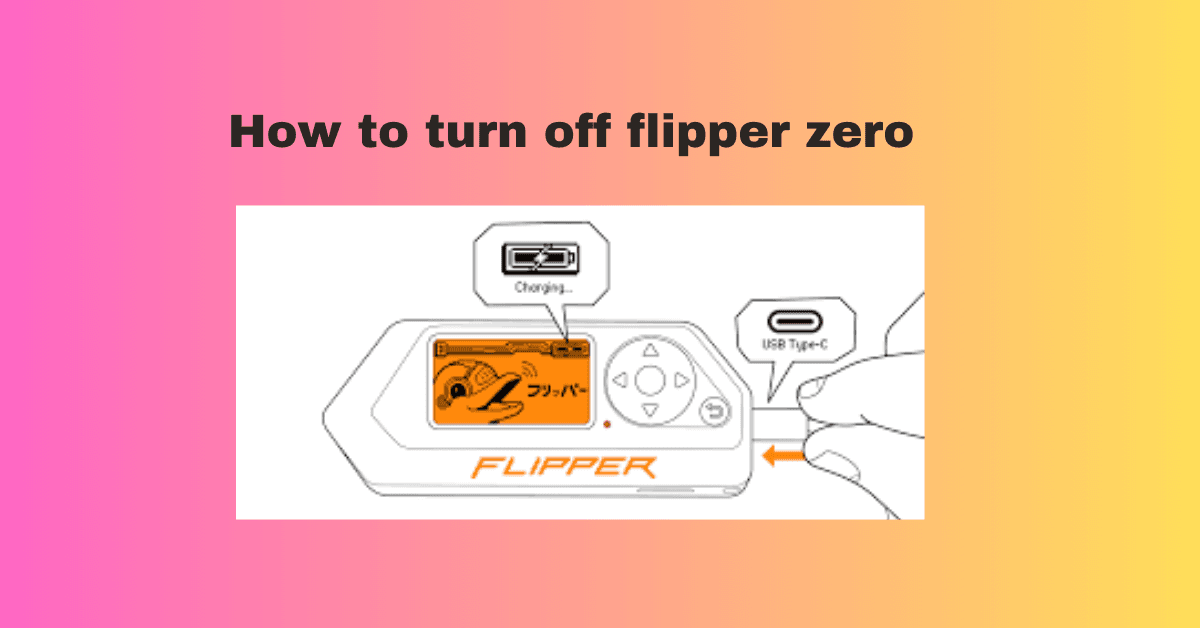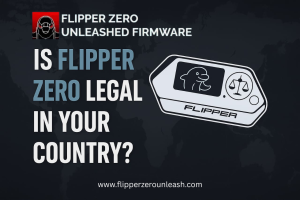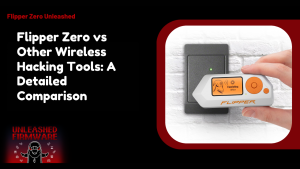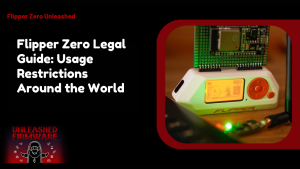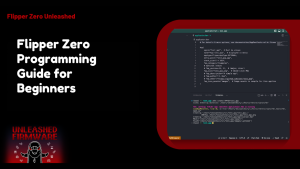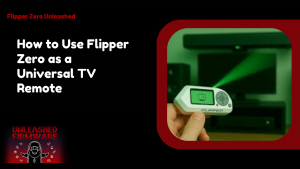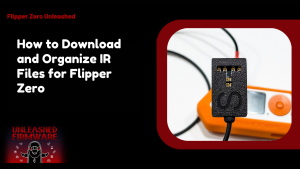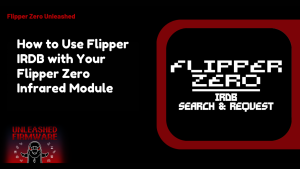Table of Contents
ToggleIntroduction
How to turn off Flipper Zero is a versatile and powerful tool that offers a range of functionalities for electronics enthusiasts, hackers, and security professionals. Properly turning off Flipper Zero is essential for maintaining its longevity and proper functioning. In this guide, we’ll explore the various methods you can use to power down your Flipper Zero safely.
How to Turn Off Flipper Zero – Methods
Turning off Flipper Zero is a straightforward process, but it’s essential to follow the correct steps to ensure you do so safely and without causing any damage to the device. Here, we’ll detail the methods you can use to power down your turn off Flipper Zero effectively:
Using the Power Button:
The Flipper Zero’s power button is typically located on the side or top of the device, depending on the model.
- To turn off your turn off Flipper Zero using the power button, locate the button and press and hold it for a few seconds.
- You should see the device’s screen or LED indicators respond, signaling it’s shutting down.
- Continue holding the power button until the device powers off ultimately.

Using the Command Line Interface (CLI):
If you’re comfortable with command-line interfaces (CLI), you can also shut down your turn off Flipper Zero using the CLI. Connect your Flipper Zero to a computer via USB and access the CLI either through a terminal emulator or a command prompt.
Once connected, execute the appropriate shutdown command. The exact command may vary depending on the operating system you’re using and the configuration of your turn off Flipper Zero.
- For Linux-based systems, the command might be
sudo shutdown now or sudo poweroff.
- For Windows-based systems, you may need to use the shutdown command with appropriate flags to specify the device to shut down.
- Ensure that you have the necessary permissions and that the turn off Flipper Zero is correctly connected before executing the command.
Using the Mobile Application:
The turn off Flipper Zero mobile application provides a convenient way to control and manage your device remotely. Open the Flipper Zero app on your mobile device, ensuring that it’s connected to the same network as your Flipper Zero.
Navigate to the power options within the app. Depending on the app’s design, this may be labeled as “Power” or “Shutdown.” Tap on the shutdown option to initiate the shutdown process. The app will send the shutdown command to your turn off Flipper Zero, and the device should power off shortly afterward.
Safety Precautions:
Regardless of the method you choose, it’s essential to ensure that your turn off Flipper Zero is powered down correctly to avoid data corruption or damage. Always follow the instructions provided for each shutdown method carefully. Before powering down your Flipper Zero, make sure it’s disconnected from any external power sources or peripherals to prevent potential damage to the device.
What to Do When Flipper Zero Doesn’t Turn Off
If your Flipper Zero isn’t shutting down using the usual methods, don’t panic—this is a fairly common issue, especially if you’re running custom firmware or have peripherals attached. First, check if there are any background processes (such as scanning or emulating) running that might be preventing shutdown. If so, try exiting those processes first via the menu or the mobile app.
Next, hold down the back button for a few seconds to attempt a soft shutdown. If that doesn’t work, confirm that the battery isn’t depleted or stuck in a boot loop. Still stuck? Then it might be time to try a forced shutdown, which we’ll explain next.
Force Shutdown Flipper Zero: Emergency Power Off
In situations where your Flipper Zero is frozen, unresponsive, or stuck in a non-functioning state, performing a force shutdown becomes necessary. To do this, press and hold the back button (usually the left-side button) for about 10–15 seconds. The screen should go black, signaling the device has been forcibly turned off.
This action won’t delete your data or settings—it’s simply a hardware-level power cut. It’s ideal for handling firmware hangs, overclocking bugs, or when modules crash unexpectedly. Once powered off, wait a few seconds before restarting to allow any residual charge to discharge from the board.
Handling Power Sources
Before shutting down your turn off Flipper Zero, it’s essential to ensure that it’s not connected to any external power sources, such as USB chargers, power banks, or other devices. This step is important,
| Point | Explanation |
| External power sources interference | External power sources can interfere with the shutdown process, leading to conflicts, disruptions, data corruption, or component damage. |
| Prevention of power fluctuations | Disconnecting external power sources prevents unexpected power fluctuations or surges during shutdown, which can harm sensitive electronics. |
| Ensuring a clean shutdown | Disconnecting external power sources ensures a clean and uninterrupted shutdown process, reducing the risk of software errors or data loss due to interruptions. |
Removing Peripherals:
To disconnecting external power sources, it’s also advisable to remove any peripherals or accessories connected to your turn off Flipper Zero before powering it down. Peripherals such as USB devices, SD cards, or other expansion modules should be safely removed to prevent any potential conflicts or data corruption during the shutdown process.
- USB devices: If your turn off Flipper Zero is connected to any USB devices, such as keyboards, mice, or storage drives, disconnect them before shutting down the device. This helps ensure that the shutdown process is not interrupted by any ongoing data transfers or device interactions.
- SD cards: If you have an SD card inserted into your turn off Flipper Zero, eject it safely before powering down the device. This prevents any potential data corruption or damage to the SD card that may occur if it’s removed while the device is still powered on.
Resetting Flipper Zero
Resetting your Flipper Zero device may become necessary in rare instances where the device becomes unresponsive, frozen, or when persistent software issues arise, helping you restore normal functionality quickly. Performing a reset can help restore the device to its factory settings, effectively clearing any software glitches or conflicts that may be causing issues.
Determine the Type of Reset:
Before proceeding with a reset, it’s essential to determine the type of reset required based on the nature of the problem you’re experiencing:
- Soft Reset: Also known as a “reboot” or “restart,” a soft reset involves simply restarting the device without affecting any user data or settings. This type of reset is typically used when the turn off Flipper Zero becomes temporarily unresponsive or freezes.
- Hard Reset: A hard reset, also referred to as a “factory reset” or “master reset,” restores the turn off Flipper Zero to its original factory settings, effectively erasing all user data and settings. This type of reset is more comprehensive and is usually performed when the device experiences persistent software issues or needs to be restored to its default state.
Performing a Soft Reset:
If your Flipper Zero is experiencing minor issues or becomes unresponsive, you can attempt a soft reset to restart the device without losing any data. Here’s how to perform a soft reset:
- Press and hold the power button on your Flipper Zero for approximately 10-15 seconds until the device powers off completely.
- Once the device has powered off, release the power button and wait for a few seconds.
- Press the power button again to turn off Flipper Zero Unleashed. The device should restart normally, and any temporary issues may be resolved.
Performing a Hard Reset:
If the soft reset fails to resolve the issue or if your Flipper Zero experiences persistent software problems, you may need to perform a hard reset to restore the device to its factory settings. Here’s how to perform a hard reset:
- Refer to the turn off Flipper Zero documentation for specific instructions on performing a hard reset. The procedure may vary depending on the model and firmware version of your Flipper Zero.
- Typically, a hard reset involves accessing the device’s settings or bootloader menu and selecting the option to restore factory settings. This process will erase all user data and settings, so ensure you have backed up any important data before proceeding.
- Follow the on-screen prompts to confirm the reset process. Once completed, the turn off Flipper Zero will restart, and you’ll need to set it up again as if it were new.
Restart vs Reset vs Shutdown: What’s the Difference?
It’s easy to confuse the terms “restart,” “reset,” and “shutdown,” but they each serve different purposes:
- Restart: Simply powers the device off and on again. It’s useful when Flipper is lagging or needs a refresh after installing new plugins.
- Reset: Comes in two forms—soft and hard. Soft reset clears memory without affecting saved settings. Hard reset restores system defaults but keeps firmware.
- Shutdown: Completely turns off the device. Required when storing the device long-term or preventing background operations.
Understanding these options helps you choose the right action for specific technical issues.
How to Power On Flipper Zero After Shutdown
Once your Flipper Zero is turned off, turning it back on is just as straightforward. Simply press and hold the right arrow button (or the OK button on newer models) for 1–2 seconds until the screen lights up. You should see the Flipper logo or boot screen appear.
If it doesn’t turn on, verify that the battery is charged. Try plugging the device into a power source using a USB-C cable. If it still fails to boot, consider checking the firmware integrity or performing a soft reset. This process is safe and won’t delete your stored data or installed apps.
Flipper Zero Frozen or Unresponsive? Here’s How to Fix It
Sometimes your Flipper Zero may freeze during operations, especially when executing complex scripts or interacting with unsupported protocols. When this happens, the buttons might become unresponsive and the screen could lock up.
To resolve this:
- First, try pressing the back button for 10 seconds to trigger a forced shutdown.
- If that doesn’t work, connect the device to your PC and access it via Command Line Interface (CLI) to push a restart command or update firmware.
- For persistent freezing, consider reflashing the firmware or factory resetting (as a last resort).
Avoid using incompatible payloads or overclocked firmware builds, as these can cause long-term instability.
How to Exit Dummy Mode on Flipper Zero
“Dummy Mode” on Flipper Zero usually activates when certain debug or restricted environments are triggered—often during firmware updates or developer testing. If your device is stuck in Dummy Mode, it may prevent normal operations or shutdown.
To exit Dummy Mode:
- Go to the Settings > System > Exit Dummy Mode (if available).
- If the menu is unresponsive, try performing a soft reset.
- Alternatively, reflash the firmware using the qFlipper desktop tool or CLI to return to standard operating mode.
Avoid installing firmware from unverified sources, as this can increase the risk of falling into debug states like Dummy Mode.
Conclusion:
Performing a reset on your Flipper Zero can help resolve software issues and restore the device to its default state. Whether you’re performing a soft reset to restart the device or a hard reset to restore factory settings, always refer to the Flipper Zero documentation for specific instructions and follow the steps carefully to ensure a successful reset process.
FAQs:
1. How do I know if my Flipper Zero is powered off completely?
After initiating the shutdown process, wait for the device’s screen or LED indicators to turn off completely. Additionally, you can try pressing the power button again; if the device doesn’t respond, it’s likely powered off.
2. Can I safely disconnect my Flipper Zero from a computer while it’s shutting down?
It’s best to wait until the shutdown process is complete before disconnecting your Flipper Zero from a computer to avoid any potential data loss or corruption. Once the device has powered off, you can safely disconnect it.
3. What should I do if my Flipper Zero doesn’t respond to the shutdown command from the mobile app?
If your Flipper Zero doesn’t respond to the shutdown command from the mobile app, try restarting the app or reconnecting your device to the network. If the issue persists, consider using a Flipper Zero alternative shutdown method, such as the power button or CLI, to ensure smoother operation and better control over the device.
4. Will performing a hard reset on my Flipper Zero delete all my stored data?
A hard reset (factory reset) on your Flipper Zero will erase all user data and settings, restoring the device to its original factory state. Be sure to back up any important data before proceeding with a hard reset.
5. How often should I reset my Flipper Zero?
Resets, especially hard resets, should only be performed when necessary, such as when the device becomes unresponsive or experiences persistent software issues. Avoid performing resets unnecessarily, as they will erase all user data and settings.
6. Is it safe to reset my Flipper Zero if it’s still under warranty?
Resetting your Flipper Zero typically does not void the warranty, as long as you follow the manufacturer’s guidelines. However, if unsure, it’s best to check the warranty terms or contact customer support for clarification.
For more tips and guidance on managing your website, visit flipperzerounleashed.com. They offer great resources for website management and security.
Latest Post
